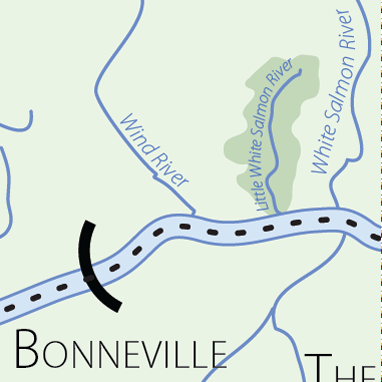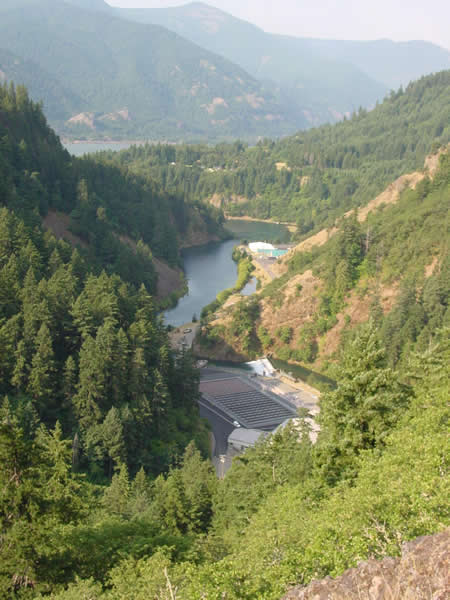
Little White Salmon River Subbasin Plan
The Little White Salmon River is one of eleven major subbasins in the Washington portion of the Lower Columbia Region. Historically, this subbasin had a limited amount of habitat accessible to anadromous fish yet it supported thousands of fall Chinook and a chum salmon population of unknown abundance. Much of the already limited habitat was lost with the construction of the Bonneville Dam. Today, numbers of naturally spawning salmon have plummeted to record lows in the tens or hundreds. Chinook and chum have been listed as Threatened under the Endangered Species Act. The decline has occurred over decades and the reasons are many. Freshwater and estuary habitat quality has been reduced by agricultural and forestry practices. Key habitats have been isolated or eliminated. Altered habitat conditions have increased predation. Competition and interbreeding with domesticated or non-local hatchery fish has reduced productivity. Hydropower construction and operation has altered flows, habitat, and migration conditions. Fish are harvested in fresh and saltwater fisheries. The Little White Salmon River will play a relatively minor role in the recovery of salmon and steelhead due to the very small amount of available habitat. Regional recovery objectives call for restoring chum from a very low to a medium viability level and maintaining fall Chinook at a low viability level.
In recent years, agencies, local governments, and other entities have addressed threats to salmon and steelhead, but much remains to be done. One thing is clear: no single threat is responsible for the decline in these populations. All threats and limiting factors must be reduced if recovery is to be achieved. An effective recovery plan must also reflect a realistic balance within physical, technical, social, cultural and economic constraints. The decisions that govern how this balance is attained will shape the region’s future in terms of watershed health, economic vitality, and quality of life.
This plan represents the current best estimation of necessary actions for recovery and mitigation based on thorough research and analysis of the various threats and limiting factors that impact Little White Salmon River fish populations. Specific strategies, measures, actions and priorities have been developed to address these threats and limiting factors. The specified strategies identify the best long term and short term avenues for achieving fish restoration and mitigation goals. While it is understood that data, models, and theories have their limitations and growing knowledge will certainly spawn new strategies, the Board is confident that by implementation of the recommended actions in this plan, the population goals in the Little White Salmon River Basin can be achieved. Success will depend on implementation of these strategies at the program and project level. It remains uncertain what level of effort will need to be invested in each area of impact to ensure the desired result. The answer to the question of precisely how much is enough is currently beyond our understanding of the species and ecosystems and can only be answered through ongoing monitoring and adaptive management against the backdrop of what is socially possible.
Key Priorities
Many actions, programs, and projects will make necessary contributions to recovery and mitigation in the Little White Salmon River Basin. The following list identifies the most immediate priorities.
1. Reduce Passage Mortality at Bonneville Dam and Mitigate for Effects of Reservoir Inundation
Anadromous fish populations in the Little White Salmon River are affected by Bonneville Dam operations including inundation of historically available key habitat in the lower river and dam passage effects. Approximately one mile of spawning habitat was inundated by Bonneville Pool. This loss of key habitat is particularly significant due to the naturally limited amount of suitable habitat in the lower river. Upstream and downstream fish passage facilities are operated at Bonneville Dam in the mainstem Columbia River but significant mortality and migration delay occurs. Adults are typically delayed in the tailrace but most eventually find and use fish ladders.
A varying percentage of adults do not pass successfully or pass but fall back over the spillway. Juvenile passage mortality results primarily from passage through dam turbines rather than spillway or fish bypass systems. Anadromous fish populations will benefit from regional recovery measures and actions identified for operations of Bonneville Dam with respect to fish passage. The suite of in-subbasin and out-of-subbasin actions will help to mitigate for habitat loss and dam passage impacts.
2. Protect Intact Forests in Headwater Basins
Portions of the Little White Salmon Subbasin, particularly those protected through Wilderness and Late Successional Reserve designations, are heavily forested with relatively intact landscape conditions that support functioning watershed processes. Streams are unaltered, road densities are low, and riparian areas and uplands are characterized by mature forests. Existing legal designations and management policy are expected to continue to offer protection to these lands.
3. Manage Forest Lands to Protect and Restore Watershed Processes
The majority of the Little White Salmon Subbasin has been managed for commercial timber production and has experienced intensive past forest practices activities. Proper forest management is critical to fish recovery. Past forest practices have reduced fish habitat quantity and quality by altering stream flow, increasing fine sediment, and degrading riparian zones. In addition, forest road culverts have blocked fish passage in small tributary streams. Effective implementation of new forest practices through the Department of Natural Resources’ Habitat Conservation Plan (state lands), Forest Practices Rules (private lands), and the Northwest Forest Plan (federal lands) are expected to substantially improve conditions by restoring passage, protecting riparian conditions, reducing fine sediment inputs, lowering water temperatures, improving flows, and restoring habitat diversity. Improvements will benefit terrestrial and aquatic species.
4. Manage Growth and Development to Protect Watershed Processes and Habitat Conditions
The human population in the basin is low but is projected to grow by at least one third in the next twenty years. The local economy is also in transition with reduced reliance on forest products.
Population growth will primarily occur along the lower and middle mainstem, especially in the vicinity of Mill A, Cook, and Willard, WA. This growth will result in the conversion of forest land uses to residential uses, with potential impacts to habitat conditions. Land-use changes will provide a variety of risks to terrestrial and aquatic habitats. Careful land-use planning will be necessary to protect and restore natural fish populations and habitats and will also present opportunities to preserve the rural character and local economic base of the basin.
5. Evaluate and Restore Passage at Artificial Barriers
A barrier dam near the mouth that is associated with the hatchery limits access to the lower mainstem below the barrier falls at river mile 3. Two miles of potentially productive habitat exists above the dam if fish health concerns can be adequately addressed. Culverts restrict passage to resident fish in the upper basin. Further assessment and prioritization of passage barriers is needed throughout the basin. Passage restoration projects should focus only on cases where it can be demonstrated that there is good potential benefit and reasonable project costs.
6. Align Hatchery Priorities with Conservation Objectives
Hatcheries throughout the Columbia Basin historically focused on producing fish for fisheries as mitigation for hydropower development and widespread habitat degradation. Emphasis of hatchery production without regard for natural populations can pose risks to natural population viability. Hatchery priorities must be aligned to conserve natural populations, enhance natural fish recovery, and avoid impeding progress toward recovery while continuing to provide fishing benefits. The Little White Salmon Hatchery Complex produces Carson stock spring Chinook, URB stock fall Chinook, and early stock coho for treaty Indian and non-Indian harvest. The main threats associated with the salmon hatchery programs are domestication of natural salmon populations and potential ecological interactions between hatchery and natural juveniles. Regional hatchery strategies and measures are focused on evaluating and reducing biological risks and reducing the risks to natural populations. The Little White Salmon Hatchery Complex will mass mark hatchery produced coho and spring Chinook which will enable out-of-basin selective fishing and accountability of hatchery fish spawning in the wild. Release strategies will be aimed at minimizing interactions between hatchery released spring Chinook smolts and wild fall Chinook and chum. The Little White Salmon Hatchery Complex will adaptively manage hatchery programs to further protect and enhance natural populations and improve operational efficiencies.
7. Manage Fishery Impacts so they do not Impede Progress Toward Recovery
This near-term strategy involves limiting fishery impacts on natural populations to ameliorate extinction risks until a combination of measures can restore fishable natural populations. There is no directed Columbia River or tributary harvest of ESA-listed Little White Salmon River salmon. This practice will continue until the populations are sufficiently recovered to withstand such pressure and remain self-sustaining. Some Little White Salmon River salmon are incidentally taken in mainstem Columbia River and ocean mixed stock fisheries for strong wild and hatchery runs of fall Chinook and coho. These fisheries will be managed with strict limits to ensure this incidental take does not threaten the recovery of wild populations including those from the Little White Salmon. Chum will continue to be protected from significant fishery impacts in the Columbia River and are not subject to ocean fisheries. State and federal legislative bodies will be encouraged to develop funding necessary to implement mass-marking of Fall Chinook, thus enabling a selective fishery with lower impacts on wild fish. Marking of fall Chinook upstream of Bonneville Dam must be addressed in the U.S. v. Oregon Forum. State and federal fisheries managers will better incorporate Lower Columbia indicator populations into fisheries impact models.
8. Reduce Out-of-Subbasin Impacts so that the Benefits of In-Basin Actions can be Realized
Little White Salmon River salmon and steelhead are exposed to a variety of human and natural threats in migrations outside of the subbasin. Out-of-subbasin impacts include drastic habitat changes in the Columbia River estuary, effects of Columbia Basin hydropower operation on mainstem, estuary, and nearshore ocean conditions, interactions with introduced animal and plant species, and altered natural predation patterns by northern pikeminnow, birds, seals, and sea lions. A variety of restoration and management actions are needed to reduce out-of-subbasin effects so that the benefits of in-subbasin actions can be realized. To ensure equivalent sharing of the recovery and mitigation burden, impacts in each area of effect (habitat, hydropower, etc.) should be reduced in proportion to their significance to species of interest.





 Subbasin plans are stored on the Northwest Power and Conservation Council’s website. All links will open on their website.
Subbasin plans are stored on the Northwest Power and Conservation Council’s website. All links will open on their website.

